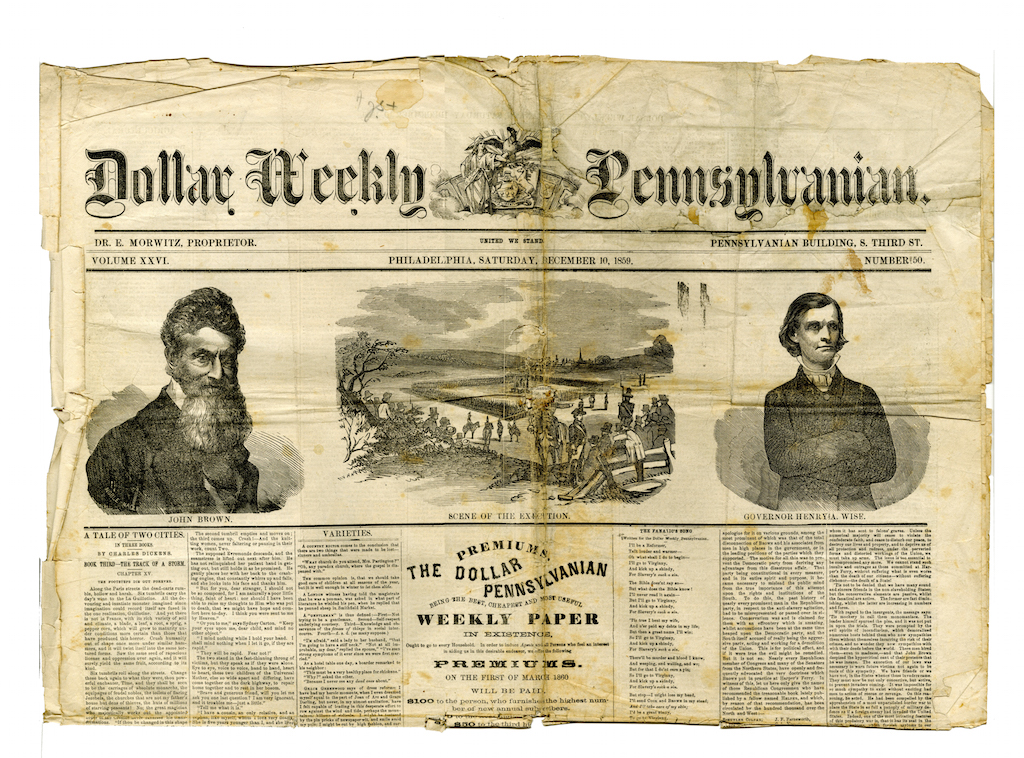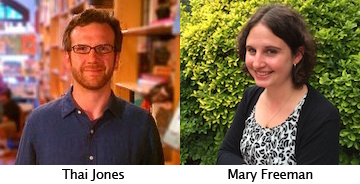In Conversation: Librarians Add a New Dimension to Online Learning at Columbia

While collaborating on Eric Foner’s Civil War and Reconstruction MOOC series, the Columbia Center for New Media Teaching and Learning (CCNMTL) and the Columbia University Libraries incorporated primary sources into each online course, allowing participants to examine high-resolution images of materials from the period: A bill of sale for the purchase of slaves, photo albums,
newspaper articles, poems, and slave auction notices. Primary sources––documents or objects created during the time being studied––provide a personal and accessible entryway into the lives, issues, and questions of history, and are a powerful way to engage students.
Primary sources can also greatly affect the way historians interpret and examine the past. A good example of this is described in a recent New York Times article on Professor Foner’s new book, Gateway to Freedom: the Hidden History of the Underground Railroad. Foner was inspired to write Gateway to Freedom after examining a small notebook––previously tucked away in Columbia’s archives––which contained meticulous details about the Underground Railroad chronicled by abolitionist Sydney Howard Gay.
Thai Jones, the Herbert H. Lehman Curator for U.S. History at Columbia University’s Rare Book and Manuscript Library (RBML), and Mary Freeman, a Columbia Ph.D. student studying 19th century American history, have curated a vast assortment of primary sources that are showcased throughout Foner’s MOOC series; in addition to the series being free and open to anyone, the materials are also accessible to K-12 teachers as open educational resources. The integration of the University’s library resources into the series has created a new dimension in online learning at Columbia, delivering unique opportunities for study and research to enterprising students.

Recently, I spoke with Thai and Mary to learn about their experience with this MOOC, and their perspectives on the evolving role of the librarian during a time of rapid change in technology, the learning sciences, and education.
What excites you about the idea of integrating primary sources into massive, open, online courses?
Thai: After more than a decade of mass digitization, researchers and students now have no shortage of historical materials at their disposal. In fact, I think that the sheer volume of available resources online is overwhelming. We have taken a less-is-more approach to the primary-source modules in the Civil War and Reconstruction MOOC. Rather than inundating participants with massive amounts of materials, we have carefully constructed intimate examinations of one or two historical texts. With careful guidelines and authentic analytical questions, we are asking students to examine these items with the level of precision and depth that a professional historian would use in her own work.
Mary: One of our main goals is to cultivate close looking and precise historical thinking in the primary source modules. One of the potential challenges of mass digitization is that a lot of sources are available online, with few strategies to use in looking at them. It is easy to become overwhelmed by data. One of my hopes is that people participating in the MOOC might be able to use the questions and strategies we give them when they are looking at other primary source images online (or in person as well).
How do you hope course participants will use these primary resources?
Thai: All too often, pedagogical literature assumes that using a primary source will in and of itself be an historically authentic learning experience. What our modules show is that no individual text can answer a complex historical question. I hope that students come away from the primary-source exercises with more questions than answers. They will see the details at a granular level that complicate or sustain grand synthesis. And the most significant opportunity for participants is the chance to catch fleeting glimpses of individual lives that may only exist now in one scrap of paper.
Mary: I think the questions we have come up with to go along with the primary sources in the MOOC aim to model how individual documents, images, and objects can be rich in historical information and that students can learn a lot by spending a significant amount of time examining just one source. I also think these sources can provoke curiosity about history in a different way than listening to a lecture or reading a history book. Particularly in the case of this course, which deals with slavery and the Civil War, I think a lot of people have an emotional response to documents dealing with individual lives. For example, a document describing the sale of an enslaved person makes the history of slavery real in a way that a lecture describing the big picture of history cannot.
How have the primary source discussions been going in Professor Foner’s courses?
Mary: So far, I think the discussions are going well. Two things have surprised me. First, I have noticed that students in the MOOC often connect their observations of the primary sources to their personal experiences and feelings. While other parts of the MOOC discussion focus on debating historical questions, the discussion of primary sources seems to prompt more personal responses, often along the lines of “If I found myself in that situation, I would do/feel. . . .”
The other thing that has surprised me has to do with sources in a digital format in comparison to my experiences discussing primary sources with students in person at the RBML. In the MOOC, students are interacting with the sources online, and they often go out and do more research online about them. I have actually learned details about the sources from the discussion boards, and students will post links to other websites or online exhibits that relate to the sources at hand.
What are the next steps, in terms of sharing these primary documents? Is there a repository in the works? A teacher-training site?
Thai: My goal is always to get archival materials out of their boxes, off the shelves, and into the hands of teachers, researchers, and students. The archive remains a prime locus of historical practice, and the accumulated records of society has important things to say about the world we live in today, and the social crises and opportunities of the future.
Mary: My understanding is that we have a goal of making some of these primary sources permanently accessible through an online exhibit. More immediately, however, I think both Thai and I want to seize any opportunities that come up to facilitate interaction between sources in the RBML and students or members of the public. The MOOC is as much of a learning experience for me as it is for the students in terms of finding out what sorts of sources and questions they respond to and how primary sources can be integrated effectively into the edX format.
Do you see the history course changing because of new technologies? How so?
Thai: The combination of new and old technologies can deeply enrich the teaching of history at every level. Online resources allow historians to discover documents that were formerly impossibly onerous to find. New technologies give a broad array of students the opportunity to access information that was once the purview of only the most privileged scholars. In service of spreading information and presenting rigorous scholarly work to the broadest audiences, new technologies are an amazing boon to research, teaching, writing, and learning. They also have their downsides. Sometimes we might confuse newness for better-ness. Yet for historians, the most important tools will always be disciplinary and conceptual -- not technological. New technologies are also commonly used as a cost-cutting measure to displace professors in a precarious job market. Good teaching, whether online or in a traditional classroom, will always come from practitioners who are confident in their job security and academic freedoms.
Mary: I absolutely agree with Thai about the positive and negative aspects of the growing presence of technology in history teaching and research. I would add that in a face-to-face classroom, I don’t think any student thinks of him or herself as a passive receptacle of the professor’s lectures, absorbing information without understanding it. Learning is an active process, regardless of the level of technology involved. In this sense, new technologies only become useful through interaction with the teachers, researchers, and students using them.
Has the proliferation of MOOCs changed your roles as librarians, in terms of your scope and mission?
Thai: The Civil War and Reconstruction MOOC’s main service to participants is to provide access to Eric Foner, a distinguished professor at an elite institution. It is an amazing opportunity for students of all ages from around the world to experience the feeling of being in the audience for one of his lecture courses. I see the primary-source component of the course in a similar vein. Columbia’s RBML has amazing, unique materials that can only be seen here. By including them in the MOOC, Columbia is presenting users with an opportunity that they would not have otherwise experienced.
Mary: I agree with Thai that the MOOC allows for members of the public to see sources held at Columbia that they otherwise might not see. For us, I think this type of work poses a new and valuable challenge. Usually librarians are trying to amass and preserve large volumes of sources, or we help individual researchers find relevant sources. But this is an opportunity for us to curate sources in dialogue with a large public audience. We choose one or two items each week that we think will encapsulate certain themes in the course, and then we get to see what types of conversation they spark among the MOOC students.
Have your jobs changed over the last few years due to more technologies for you to utilize (better scanners, online repositories and galleries, online courses, etc.)?
Thai: Faculty interest in incorporating archival materials into their teaching is higher than it has ever been. At the Rare Book & Manuscript Library, the curators find themselves interacting with more students and professors than ever before. Researcher use of special-collections repositories is also growing. As more materials are digitized and collections become more accessible through searchable online finding aids, more researchers, professors, and students will be introduced to the unique holdings that can only be found in archives.
Mary: For graduate students, there is a growing expectation that we will be familiar with technology and digital humanities to use in our research and teaching. For my own research, I have been really impressed with how much is available online in terms of digitized primary source documents. And I have certainly seen undergraduates take advantage of that as well. You can really take on a sophisticated research project as an undergraduate, like a senior thesis, and do a lot of research online.
---
Every week the MOOC production team–Foner, his teaching assistants, CCNMTL staff, and the RBML team–delivers a new primary source “unit” comprised of up to four high-resolution images that can be zoomed in for close examination; supplemental background information about the primary sources; and a list of questions to think about and use for discussion. Participants not only have access to these valuable Columbia University Library artifacts, but they can also discuss their significance by engaging in conversations with each other, with Professor Foner and his teaching assistants, and with the library curators.
The addition of library professionals to the Civil War and Reconstruction MOOC team has strengthened, and enhanced Columbia’s efforts in online learning. Resources once locked inside of library walls are now a click away, allowing access for an ever-growing population of learners around the globe. We are still scratching the surface in terms of what can be done in an open online course, making this a very exciting time for teachers, designers, librarians and, most importantly, learners everywhere.
The third course of the Civil War and Reconstruction series begins on February 25, 2015. Register today: bit.ly/cwrMOOC3


